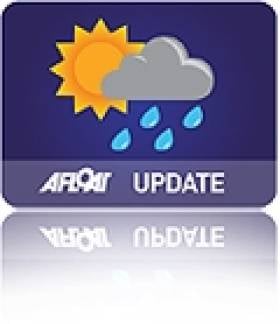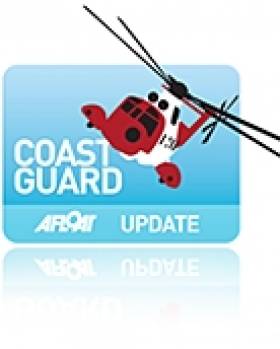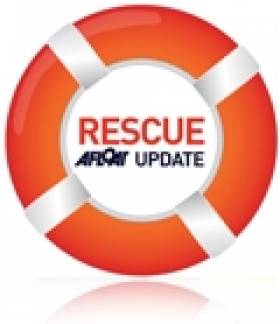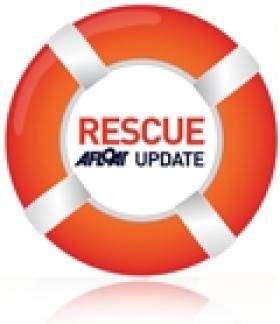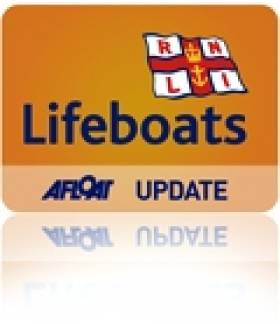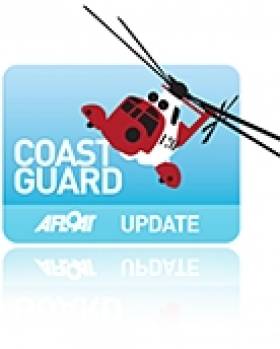Displaying items by tag: Irish Coast Guard
Public Urged To Be Aware of Water Risks as Temperatures Soar
#Weather - Irish Water Safety has urged anyone heading to the water on lakes, rivers or beaches during this week's heatwave to take extra precautions as Met Éireann issues a 'yellow warning' amid soaring temperatures.
Speaking to TheJournal.ie, IWS chief John Leach underlined the increased risk of drownings during warmer periods, especially among young people in their teens or early twenties to go swimming in unsupervised areas.
Only today RTÉ News is reporting on the death of a 21-year-old Lisa Knight, who drowned while swimming with friends on the River Feale in Co Limerick in the early hours of this morning.
The heatwave, which is expected to peak on Friday with temperatures in many parts breaking the 30s, has drawn people to coastal areas in droves.
Also on TheJournal.ie, the Irish Coast Guard has reported a 40% increase in call-outs relating to watersport and other leisure activities over the last three weeks compared to the same period in 2012.
A significant number of these relate to rogue jetskiers "tormenting" beach-goers by racing through designated swimming areas on their personal water craft, according to IRCG operations manager Declan Geoghehan.
In related news, the Irish Independent says hoax calls to the coastguard have increased 40-fold since the IRCG was added to the main emergency services accessible by dialling 999 or 112 - and now constitute the "vast majority" of calls received.
#Coastguard - The Irish Coast Guard has advised members of the public to pay special attention to water safety this week.
The warm, sunny weather with temperatures in the high 20s is forecast to last for the rest of the week and the weekend, when traditionally many people take to the water and enjoy outdoor activities.
Irish Coast Guard manager Declan Geoghegan said: “Warmer weather encourages everyone to enjoy the outdoors and brings thousands of people to our coastlines, to our beaches and the outdoors. We want everyone to enjoy the outdoors but to remember to take simple, basic advice about staying safe on the water and along cliff paths, when hill walking and enjoying the outdoors.
"Time and again, we see people ignoring basic safety advice, taking risks and then getting into difficulty, sometimes leading to loss of life. The coastguard is a 24/7 service but we must again advise caution as too many people are taking risks and ignoring our advice.”
Last month the Irish Coast Guard launched its first TV water safety campaign, as well as a summer campaign designed to protect children on beaches and near coastlines. The coastguard made available thousands of free waterproof wristbands under the ‘Give Us A Hand’ campaign.
“This summer we began our 2013 safety awareness campaign in May and we want to strongly get across the safety message to families, leisure users and the fishing industry about going out on the water," said Geoghegan.
"We want everyone to enjoy the outdoors this summer weather but remember to heed our advice to ensure that you and your family and friends stay safe."
Busy Weekend With Four Call-Outs For Portaferry RNLI
#RNLI - Portaferry RNLI in Co Down had a busy weekend with four separate call-outs over the two days.
The first came on Saturday 6 July following a report that three children were drifting offshore on an inflatable toy.
The volunteer lifeboat crew was already afloat on exercise as part of the annual raft race in Kircubbin, Co Down, when they got a call to go to the aid of the three children aged 10, 11 and 14 who were drifting out to sea on the inflatable 18 miles away at Cloughey Bay.
Thankfully by the time they arrived on scene a local coastguard unit had already attended and brought the three children to safety on shore.
Portaferry RNLI was called out for a second time at 4.10pm to rescue a number of people on board a speedboat that had lost power in Strangford Lough just off Killyleagh.
The crew arrived at the scene at 4.15pm, by which time the 15ft speedboat had already been towed in and was moored at the pontoons at Killyleagh Yacht Club in Strangford Lough.
On both occasions the weather was fine with good visibility and calm seas.
Yesterday (7 July) the volunteer crew launched for the third time to assist an injured woman on Salt Island in Strangford Lough.
The crew arrived at the island at 10.10am and assessed the situation before transporting two paramedics from Killyleagh to the injured woman, who was subsequently airlifted by Irish Coast Guard helicopter to Musgrave Park Hospital in Belfast for treatment.
At 11:35am, while returning to the lifeboat station, the crew was alerted once again, this time to go to the aid of two men onboard a five metre Dory that had lost power and was drifting just off Ringhaddy Sound in Strangford Lough.
The crew arrived on the scene at 12.05pm and took the men onboard the lifeboat, towing the powerless boat into Strangford Lough Yacht Club, where the men were then put ashore and their boat tied up.
Elsewhere in Northern Ireland, Newcastle RNLI assisted two men after their motor cruiser ran aground off the Co Down coast last Thursday (4 July).
The volunteer crew launched their inshore lifeboat at 2.20pm following a report from Belfast Coastguard that a small vessel had ran aground off Dundrum Bar with two people on board.
Weather conditions at the time were described as blowing south westerly four to five winds with moderate to choppy seas. There was good visibility.
The lifeboat, helmed by Nathan Leneghan and with crew members Declan Barry and Charles McClelland on board, arrived on scene at 2.30pm, where they observed that one of the men had made it to shore while the other was still on the 5m boat.
Speaking following the call-out, Newcastle RNLI deputy launching authority Joe McClelland said: "Thankfully, no one was in immediate danger and we were happy to bring the vessel and the man who was still on board safely to shore."
Teen Rescued From Howth Cliff Edge
#Rescue - TheJournal.ie reports that 15 members of the Irish Coast Guard's Cliff Rescue Unit were involved in the rescue of a 16-year-old boy trapped on a cliff edge on Howth Head in North Dublin on Saturday evening (6 July).
According to Howth Coast Guard, the teen had tried to climb up from the beach at Whitewater Brook but became stranded halfway up the cliff face.
Coastguard staff received the emergency call around 9.40pm and the rescue unit was on scene within 10 minutes. The teen was quickly recovered to the cliff top with no reported injuries.
Whitewater Brook was recently the scene of a joint cliff rescue training exercise involving the Howth Coast Guard and the Irish Red Cross.
New Emergency Info System Put Through Its Paces
#Rescue - The Irish Coast Guard and the RNLI were among the emergency services putting some new communication technology to the test last month.
As Phys.org reports, the emergency exercise in Malahide Estuary was designed to test the effectiveness of REACT, or Resource for Emergency services to Access Command and control data using satellite and hybrid Technologies.
The system, funded by the European Space Agency (ESA), employs satellite, mobile and other communications systems to maintain a constant open channel between different response services, even if one network goes down during a crisis.
Rescue teams in the field can also remain in two-way multimedia contact with co-ordinators in the control room to ensure the right people are where they need to be as quickly as possible.
Ritchie Hedderman, head of operations at the Dublin Fire Brigade, which also took part in the exercise, said: "In the event of a major emergency, secure and reliable communications are vital to the emergency services.
"I feel that the satellite communications in time will prove to be the primary and preferred means for communicating as it can supply voice, video and data back to regional and national control centres where strategic commanders can assess situation on the ground and provide the back up resources in order that a successful conclusion to the emergency can be obtained."
Phys.org has much more on the story HERE.
Skerries RNLI Assists Lone Sailor On Grounded Yacht
#RNLI - Skerries RNLI launched shortly before 7pm yesterday evening (Thursday 27 June) to assist an 11m yacht with one person on board that had run aground north of Rush Harbour.
The Dublin branch of the Irish Coast Guard requested Skerries RNLI to launch after two members of the public, who had been out kayaking, reported that the yacht was in difficulty.
Weather conditions at the time were a force one to two wind with calm seas.
The lifeboat, helmed by Willie Boylan with crew members Conor Walsh, Karl Duff and Peter Kennedy on board, was on scene in less than 10 minutes. However, by that time the yacht was completely aground above the tide line.
Two volunteer crew members were put ashore to assess the casualty vessel. There was only one person on board and he was not in any immediate danger. There also appeared to be no significant damage to the hull of the boat.
The crew members laid out an anchor from the vessel to ensure that it did not drift onto the nearby rocks when it began to float again. Irish Coast Guard helicopter Rescue 116 was also on scene briefly to ensure that no assistance was required.
With the tide still falling, the decision was taken for the lifeboat to return later after the tide had turned to ensure that the yacht floated safely and to assist in helping it safely back to a harbour.
At 10.20pm the volunteer crew launched the lifeboat again to attend to the yacht, this time with Conor Walsh at the helm and Karl Duff, Eoin Grimes and Emma Wilson as crew, bringing a salvage pump with them.
One of the crew was put ashore to check on the casualty again and to secure a tow line to the boat. As the tide rose, the lifeboat kept the tension on the tow to prevent the yacht being pushed further on to the rocks.
At 11.45pm the yacht was refloated and guided back to Skerries Harbour with the lifeboat leading the way to help navigate around the islands safely in the dark.
Speaking after, Skerries RNLI lifeboat operations manager Niall McGrotty said: "There didn’t appear to be much damage and the conditions were calm. However, it was a large boat with a lot of equipment on board, so there were some concerns around whether it would refloat successfully. Thankfully, it did and everyone made it home safe and sound."
#Coastguard - The Irish Coast Guard (IRCG) has launched a new summer water safety campaign designed to protect children on beaches and near coastlines.
The IRCG is distributing thousands of free waterproof wristbands under the ‘Give Us A Hand’ campaign.
Parents or guardians can write their phone numbers on the wristband so that lifeguards, emergency services or members of the public can contact the child’s parents if the child becomes lost or becomes separated.
The wristbands have been made available to IRCG volunteer units for distribution through schools, lifeguard stations and maritime community events around the country. The wristbands carry a message reminding the public to call 112 and ask for the coastguard for beach, water or cliff emergencies.
The wristband concept is very simple: it’s made of water resistant Tyvek material which is strong and difficult to tear. The bands were designed and developed free of charge by coastguard volunteers and are a practical, simple way to assist families.
Finding a lost child at a busy beach is a very stressful experience for both parent and child. Coastal or waterside areas present further dangers with open water, sand dunes and exposed cliffs all adding to concerns.
Following a day at the beach, the band can easily be removed using scissors and disposed of by a parent or guardian.
This is the latest stage in the Irish Coast Guard’s summer safety campaign headed by its first TV advertising campaign, as previously reported on Afloat.ie.
Meanwhile, the Galway Advertiser reports that Galway City councillors have approved €6,000 in funding for promoting water safety in the city.
Sunny Days See Coastguard's Busiest Period in Two Decades
#Coastguard - Last weekend 8-9 June was the Irish Coast Guard's busiest since 1991 for search and rescue indigents, as reported yesterday on Afloat.ie.
Today's Irish Examiner goes deeper into the figures, which show more than 53 coastguard search and rescue incidents took place around the country last Saturday and Sunday - ranging from missing persons to swimmers in difficulty, vessels broken down, missing children, personal watercraft and speedboats operating in a hazardous way and urgent medical evacuations.
In addition, the Irish Coast Guard's rescue helicopter fleet – not including any of the other IRCG units – was tasked a massive 18 times over the weekend alone.
The fleet was this week bolstered by the arrival of two Sikorsky S-92s previously flown by the British Coastguard.
Set to operate from Shannon, the choppers join the state-of-the-art Rescue 115 which has been operational since last year, and was last week on course to conduct the Irish Coast Guard's longest range mission ever.
Irish Coast Guard Launches TV Water Safety Campaign
#Coastguard - The Irish Coast Guard (IRCG) has launched its new 'Stay Safe on the Water' TV advertising campaign aimed at families, leisure users and the fishing industry during the busy summer months.
This is the coastguard’s first TV advertisement, having its premiere on RTÉ One television this evening after 6pm.
The IRCG was motivated to launch its first TV water safety campaign following the success of the Road Safety Authority (RSA) TV campaigns. The new 20-second adverts will run from now until the end of August.
Coastguard statistics have recorded 11 deaths by drowning in Irish waters so far this year, and last weekend was the Irish Coast Guard's busiest since 1991 for search and rescue incidents.
Speaking at the launch, IRCG manager Declan Geogheghan said: “This summer we began our 2013 safety awareness campaign in May and we want to strongly get across the safety message to families, leisure users and the fishing industry about going out on the water.
"We want everyone to enjoy the outdoors this summer weather but remember to heed our advice to ensure that you and your family and friends stay safe.”
Last Saturday and Sunday saw more than 53 coastguard search and rescue incidents taking place around the country. Of these, 21 were co-ordinated by the Dublin Marine Rescue Co-ordination Centre (MRCC), 18 by Valentia MRCC and 14 by Malin MRCC.
These incidents ranged from missing persons, swimmers in difficulty, vessels broken down, missing children, personal watercraft and speedboats operating in a hazardous way and urgent medical evacuations.
Coastguard helicopters alone – not including any of the other IRCG Units – were tasked a massive 18 times over the weekend.
“The pleasant, warm weather brings thousands of people to our coastlines, to our beaches and the outdoors," said Geoghegan. "We want everyone to enjoy the outdoors but to remember to take simple, basic advice about staying safe on the water and along cliff paths, when hill walking and enjoying the outdoors.
"Time and again, we see people ignoring basic safety advice, taking risks and then getting into difficulty, sometimes leading to loss of life. The coastguard is a 24/7 service but we must again advise caution as too many people are taking risks and ignoring our advice.
For specific advice and information on any water and coastal activity, visit www.safetyonthewater.ie.
Throughout the summer, as at other times of the year, Irish Coast Guard units throughout Ireland will patrol our waterways and coastlines issuing safety advice and information to holidaymakers, tourists and marine users.
The following are general safety tips and advice from the IRCG to help enjoy the water and coastal activities in your area this weekend and throughout the summer:
Swimming
Only swim at beaches and waterways that have lifeguards on duty and pay attention to the safety flags. Ask the lifeguard for advice about safety and water conditions and adhere to their instructions. Avoid using inflatable toys, such as li-los and rubber rings, on the water.
Cliff Walking
There is safety in numbers, so never be alone if possible. Let somebody know when and where you are going and what time you will be back. Stay well away from the cliff edge, both top and bottom. Don’t attempt to rescue people or pets if they fall over the edge. If assistance is required dial 999 or 112 and ask for the coastguard.
Water Sports and Coastal Activities
Before going to sea check local weather conditions and tides in the area. Wear correctly maintained and fitting lifejackets that are suitable for the activity. Lifejackets are of no use unless they are worn. Ensure your craft is fit for purpose. Always advise someone as to where you are going and the time of your intended return. Do not overload the craft. If you are in difficulty or see someone in difficulty and requiring assistance dial 999 or 112 and ask for the coastguard.
Finally, under no circumstances should anyone ever engage in water activities under the influence of alcohol.
#Coastguard - What would have been the Irish Coast Guard's longest ever rescue mission was stood down at the last minute after the casualty in question was deemed to be in a stable condition.
According to the Irish Independent, the Shannon-based coastguard rescue helicopter was dispatched on the 300-nautical-mile mission to retrieve a man in his 70s from a cruise liner en route to Cobh from the United States.
The distance was so great that the helicopter, the new Sikorsky S-92 with the call sign Rescue 115, was forced to land on an offshore oil rig 180km off Kerry to refuel.
While there the chopper experienced a technical issue and was grounded for safety reasons while an engineer was sent to the oil rig on board Waterford's Rescue 117.
However, in the meantime a second doctor on board the MS Marina determined that the patient - who was feared to have had a stroke - was in a stable enough condition to be transferred to hospital upon the ship's arrival in Cobh early today.
The Irish Examiner confirms that the casualty was a 79-year-old American.


























